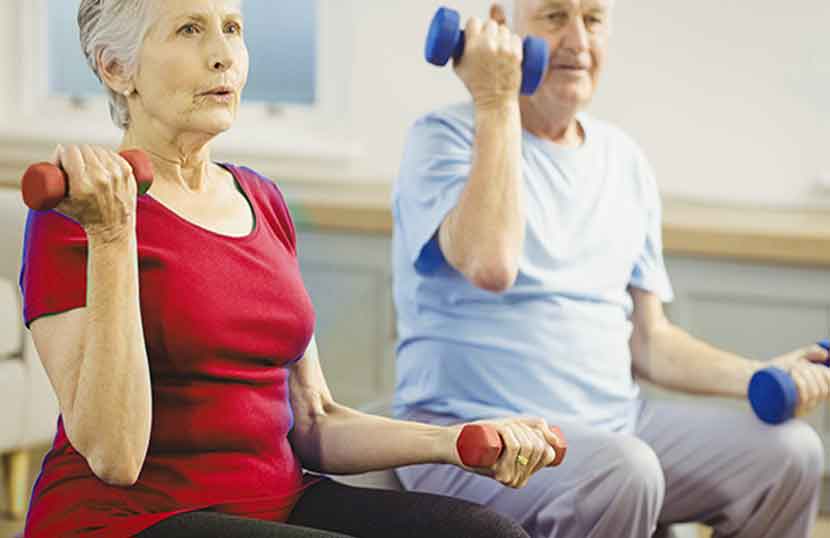Osteoporosis is a disease in which the bones become weak and are more likely to break. People with osteoporosis most often break bones in the hip, spine, and wrist.
Who Gets Osteoporosis?
In the United States, millions of people either already have osteoporosis or are at high risk due to low bone mass.
Osteoporosis can occur in both men and women and at any age, but it is most common in older women.
- What Causes Osteoporosis?
- Can Osteoporosis Be Prevented?
- What Are the Symptoms of Osteoporosis?
- How Is Osteoporosis Diagnosed?
- How Is Osteoporosis Treated?
- How Can I Prevent Falls?
What Causes Osteoporosis?
Many risk factors can lead to bone loss and osteoporosis. Some of these things you cannot change and others you can.
Risk factors you cannot change include:
- Gender. Women get osteoporosis more often than men.
- Age. The older you are, the greater your risk of osteoporosis.
- Body size. Small, thin women are at greater risk.
- Ethnicity. White and Asian women are at highest risk. Black and Hispanic women have a lower risk.
- Family history. Osteoporosis tends to run in families. If a family member has osteoporosis or breaks a bone, there is a greater chance that you will too.
Other risk factors are:
- Sex hormones. Low estrogen levels due to missing menstrual periods or to menopause can cause osteoporosis in women. Low testosterone levels can bring on osteoporosis in men.
- Anorexia nervosa. This eating disorder can lead to osteoporosis.
- Calcium and vitamin D intake. A diet low in calcium and vitamin D makes you more prone to bone loss.
- Medication use. Some medicines increase the risk of osteoporosis.
- Activity level. Lack of exercise or long-term bed rest can cause weak bones.
- Smoking. Cigarettes are bad for bones, and the heart, and lungs, too.
- Drinking alcohol. Too much alcohol can cause bone loss and broken bones.
Can Osteoporosis Be Prevented?
There are many steps you can take to help keep your bones healthy. To help keep your bones strong and slow down bone loss, you can:
- Eat a diet rich in calcium and vitamin D
- Exercise
- Not drink in excess or smoke.
Nutrition
A healthy diet with enough calcium and vitamin D helps make your bones strong. Many people get less than half the calcium they need. Good sources of calcium are:
- Low-fat milk, yogurt, and cheese
- Foods with added calcium such as orange juice, cereals, and breads.
Vitamin D is also needed for strong bones. Some people may need to take vitamin D pills. The chart on this page shows the amount of calcium and vitamin D you should get each day.
Definitions: mg = milligrams; IU = International Units
Source: Food and Nutrition Board, Institute of Medicine, National Academy of Sciences, 2010.
Exercise
Exercise helps your bones grow stronger. To increase bone strength, you can:
- Walk
- Hike
- Jog
- Climb stairs
- Lift weights
- Play tennis
- Dance.
Healthy Lifestyle
Smoking is bad for bones as well as the heart and lungs. Also, people who drink a lot of alcohol are more prone to bone loss and broken bones due to poor diet and risk of falling.
What Are the Symptoms of Osteoporosis?
Osteoporosis is called the “silent disease” because bone is lost with no signs. You may not know that you have osteoporosis until a strain, bump, or fall causes a bone to break.
How Is Osteoporosis Diagnosed?
A bone mineral density test is the best way to check your bone health. This test can:
- Diagnose osteoporosis and tell you whether you are likely to break a bone.
- Check bone strength
- See if treatments are making the bones stronger.
How Is Osteoporosis Treated?
Treatment for osteoporosis includes:
- A balanced diet rich in calcium and vitamin D
- An exercise plan
- A healthy lifestyle
- Medications, if needed.
How Can I Prevent Falls?
Men and women with osteoporosis need to take care not to fall down. Falls can break bones. Some reasons people fall are:
- Poor vision
- Poor balance
- Certain diseases that affect how you walk
- Some types of medicine, such as sleeping pills.
Some tips to help prevent falls outdoors are:
- Use a cane or walker
- Wear rubber-soled shoes so you don’t slip
- Walk on grass when sidewalks are slippery
- In winter, put salt or kitty litter on icy sidewalks.
Some ways to help prevent falls indoors are:
- Keep rooms free of clutter, especially on floors
- Use plastic or carpet runners on slippery floors
- Wear low-heeled shoes that provide good support
- Do not walk in socks, stockings, or slippers
- Be sure carpets and area rugs have skid-proof backs or are tacked to the floor
- Be sure stairs are well lit and have rails on both sides
- Put grab bars on bathroom walls near tub, shower, and toilet
- Use a rubber bath mat in the shower or tub
- Keep a flashlight next to your bed
- Use a sturdy step stool with a handrail and wide steps
- Add more lights in rooms
- Buy a cordless phone to keep with you so that you don’t have to rush to the phone when it rings and so that you can call for help if you fall.
For More Information About Osteoporosis and Other Related Conditions:
-
NIH Osteoporosis and Related Bone Diseases ~ National Resource Center
2 AMS Circle
Bethesda, MD 20892-3676
Phone: 202-223-0344
Toll free: 800-624-BONE (2663)
TTY: 202-466-4315
Fax: 202-293-2356
Email: NIHBoneInfo@mail.nih.gov
Website: http://www.bones.nih.gov

